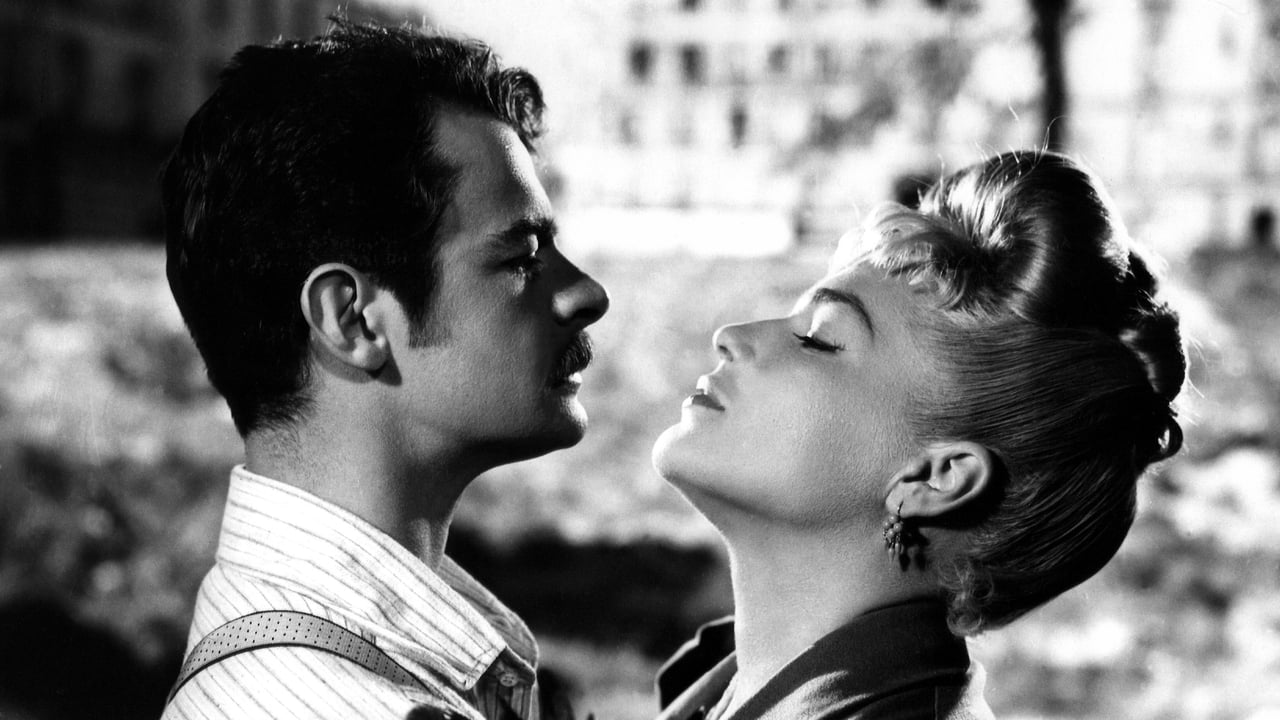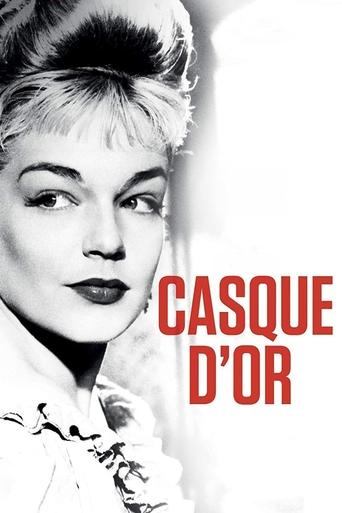

What makes it different from others?
... View MoreAbsolutely brilliant
... View MoreTrue to its essence, the characters remain on the same line and manage to entertain the viewer, each highlighting their own distinctive qualities or touches.
... View MoreThe thing I enjoyed most about the film is the fact that it doesn't shy away from being a super-sized-cliche;
... View MoreDeciding to spend the next 100 days watching 100 French films,one of the main goals I gave myself was to watch as many of auteur film maker Jacques Becker's 13 credits (with the superb Antoine et Antoinette being the only one I've seen before.) Taken by Simone Signoret's role in Henri-Georges Clouzot's chilling Les Diaboliques,I was delighted to find a title where Signoret and Becker teamed up,which led to me putting on the Casque D'or (Golden Helmet.)The plot:Getting out of jail,former gangster Georges Manda vows to stay on the straight and narrow.Returning to town,Manda crosses paths with powerful gangster Félix Leca.Attending a dance hall,Manda meets Marie,and falls in love at the very first sight of her.Taken by his rugged appearance,Marie finds herself starting to secretly fall for Manda. Furious over Marie having eyes for another man,Leca's gang member Roland Dupuis challenges Manda to a fight to the death for Marie.Killing Dupuis,Manda and Marie decide to leave town and run to the countryside. Desperate to get their revenge,Leca's gang decide to plant Dupuis's murder on Manda's old friend Raymond. View on the film:Rowing into the movie,co-writer/(along with Jacques Companéez/ Annette Wademant & "Romi") director Jacques Becker & cinematographer Robert Lefebvre enter Leca's underworld with an immaculate shine,with the razor sharp suits,gold-covered walls and blazing sun keeping the evil under the sun bubbling away.Along with expert use of deep focus shading in Marie's transfixing face,Becker chips away at the sunlight to crack the Film Noir darkness,which pours out in stylish reflecting mirror shots gazing at the fractures Leca is creating,and powerfully raw, unflinching close-ups punching into the Film Noir darkness Manda has returned to.Looking ravishingly beautiful, Simone Signoret gives an incredible performance as dame Marie,where Signoret displays a subtle grip on make each facial expression (no matter how minor) express the developing love Marie has for Manda.Caught in the middle of a vicious set-up, Raymond Bussières gives a great performance as Raymond, (how long did they spend think up that name for him!)by making Ray try in desperation to hold onto a gentleman's loyalty,even as the Film Noir pit caves in. Finding himself unable to escape the old crowd, Serge Reggiani gives a superb performance as Georges Manda,via balancing a heart-wrenching love for Marie with a chewy Film Noir grit,as Manda sets his sights of Marie and Leca.Following Manda back into the darkness,the screenplay by Becker/ Companéez/ Wademant & Romi brilliantly twist Manda's Film Noir world round Marie's little finger,which slides in on a silk,romantic atmosphere,where the writers place a tense sense of longing between the couple.Clawing away at the dapper dress of Leca,the writers dip Becker's theme of loyalty into deadly Film Noir waters which tear Film Noir loner Manda's between loyalty for his friend,and loyalty for his love,the girl with the golden helmet.
... View MoreThis is a dream of a movie. Not full of action, yet packed with memorable moments and whole sequences. The stunning opening with the rowing boats on the river and the singing accompaniment, the slow build up and rapid denouement of the execution at the end and so much more in between. I was surprised upon opening my DVD to see the film originated in 1952 because I had imagined I had seen it upon it's London film release. The, thanks to another IMDb reviewer, I discover that the film was quickly pulled upon initial release and not released again until nine years later when it is perfectly feasible that I saw it in the West End. Simone Signoret! What can one say? Even to a youngster today, used to seeing 'stars' come and go so easily, would surely appreciate the subtle allure that seemed to come so naturally to this beautiful woman, who invigorated so many excellent films.
... View MoreJacques Becker's CASQUE D'OR (Golden Helmet 1952), an underworld romance set in Paris during "La Belle Epoque", stars Simone Signoret as the titular blonde prostitute who's star-crossed amour reveals the agony and ecstasy of love. The buxom Signoret plays Marie, the moll of an Apache gangster, who meets Manda, an ex-con gone straight, at an al fresco dance hall and it's love at first sight for both of them. The pair soon throw caution to the wind, setting off a chain-reaction of jealousy, murder, double-crosses, and revenge that can only end in tragedy. All of the characters are sharply etched but it's Simone Signoret's Marie who literally shines. The tough and tender demimonde can't take her eyes off Manda (a quiet, determined Serge Reggiani) from the moment they meet until the bitter end and she's often bathed in an ethereal light. The duplicity-free Marie is also the quintessential femme fatale who proves bad luck to any man who covets her. The era is imaginatively realized and a number of scenes are reminiscent of Impressionist paintings yet, like Marie's unconscious duality, there's darkness in the light with an undercurrent of understated but potent sex and violence. Highly recommended and loosely based on an incident in the life of a bisexual bonvivant, one Amélie Hélie:"The bands of roughnecks of Belleville were also a passionate lot, not like the cynical pimps of Montmartre and La Chapelle. Here a man took out a knife for a girl he really cared for. In 1902 the story of 'Casque d'Or' made the headlines throughout Paris, both east and west. Two enemy bands of Apaches Mohicans de Paris - sporting their customary insignia of caps, bell-bottom trousers and polka-dotted scarves, had taken to the streets that lay between Belleville and Charonne: 'Le Popincourt' headed by the Corsican Leca, 'Les Orteaux' by Manda, l'Homme! The object of their dispute was not territory but a girl called Amélie Hélie, nicknamed 'Casque d'Or', with a stunning, golden-reddish mane. The confrontation turned into a fullscale pitched battle on Rue des Haies, in which neither knife blades nor guns were spared. To the inquisitive public prosecutor Manda retorted during his trial: 'We fought each other, the Corsican and myself, because we love the same girl. We are crazy about her. Don't you know what it is to love a girl?' Manda was unquestionably a soulmate of Piaf. Condemned to deportation and hard labour - Manda for life, Leca for eight years - the two men met on the island of Saint-Martin-de-Ré. When finally they spoke to each other, it was about 'Casque d'Or'. She meanwhile wasted no time bewailing her unfortunate suitors, but turned for solace to the world of entertainment and the company of wealthier men. However, one of Leca's faithful followers had been contemplating revenge and stabbed her one night in the establishment where she sang. Although she survived, she could no longer perform as a singer and it is only thanks to her portrayal by the legendary Simone Signoret in Jacques Becker's movie that she has not fallen into oblivion. The real Amélie Hélie ended by marrying an ordinary workman and died forgotten on 16 April 1933. She was buried in the cemetery of Bagnolet."CASQUE D'OR's release was briefly delayed when Amélie's widower attempted to take out an injunction against it, claiming the film invaded his late wife's privacy. The case was soon thrown out when it was revealed that Hélie had appeared on stage, playing herself, in a drama entitled "Casque d'or et les Apaches".
... View MoreOne more memory game: I'd been wanting to re-see this for years after a single Pacific Film Archive screening I'm not sure what decade. Memories of style as attack, attack by aura, dancers and fighters tracing curves across the screen. Manda's one-armed grab of Marie's waist the first time he dances with her. All the film's men swaggering, strutting, dancing with pointed nonchalance. Cummerbund things. Caps, derbies. Knives. Guns?! Yes, there are guns, but those I'd forgotten. The knife fight that my memory placed near the end, High Noon style, actually starts things moving. Maybe -- I'm only slightly ashamed to say it since I know hundreds of French films -- a little bit of Chuck Jones' or Pepe le peu's France had leeched into what I remembered. Or maybe it was Popeye introduced me to apache dancers.So now I own it. Most of the story returns as I watch.Just one small thing I want to say though, that anyone else might not, has to do with what photographers call highlights. Only two characters, Marie "Casque d'or" and her Manda, get eye sparkles. Especially when they're with each other or thinking of the other or her eyes are tearing, Becker and his photographer allow a bit of maxed out exposure, to us gleam, a twinkle, a tiny bit of white screen in a black pupil. Did they manually scrape the film to allow light to show through? Some when zoomed in upon look like little crosses, or multi-pointed stars with long axes. They're quite intricate. I've never developed film, but know from converting digital images in my editing software to black and white that this is both difficult to achieve naturally with a camera and difficult to create after the fact so as to look natural. But it's no lucky stroke that the two lovers' eyes gleam. Becker did it. The only other character allowed this sparkle is Leca, a single instance, I think right before he forces himself on Marie.Light laces the film's parts. The boats of the opening emerge from a silver white landscape as simply, deceptively simply, conceived as sumi-e. The girls and the gang soon turn the light into motion on the dance floor. The "swells" are light, as is any and every sheet Marie has lain upon. Does the guillotine blade sparkle? Probably not. I've forgotten again already.Touch points? Not for light, but for motion, dance, and both male and female confidence and swagger: Carlos Saura's Carmen and Blood Wedding.
... View More